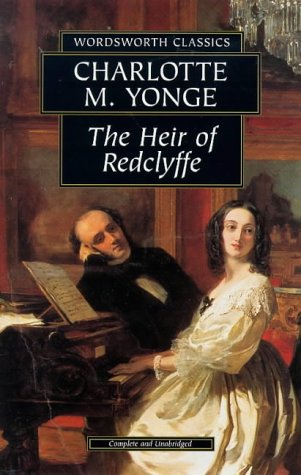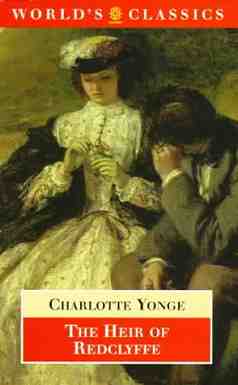|
Sintram and The Heir of Redclyffe article by Julia Courtney Online text of The Heir of Redclyffe |
 |
 |
|
A 1998 edition of The Heir of Redclyffe
was produced by Wordsworth
Classics | ||
|
Until recently an edition with an introduction
by Barbara Dennis was available in the Oxford University Press World's Classics series. It is now out of print, though copies can still be found (ISBN: 0192831321) |
First published in 1853, The Heir of Redclyffe was among the most successful novels of the century, equalling even the work of Dickens and Thackeray in popularity.
The story of a clash of personality between well-born cousins, Guy Morville and Philip Edmonstone, the plotfocuses on Guy's spiritual struggle to overcome the darker side of his nature. Philip's sinister insinuations about Guy's character almost thwart Guy's marriage to the gentle Amy, yet despite their bitter feuding the novel reaches an unexpected and dramatic conclusion that vindicates romantic virtue, self-sacrifice, and piety, epitomizing the period's nostalgia for an idealized chivalric past. Adopted by William Morris and Burne-Jones as 'a pattern for actual life', Guy was a popular role model of noble virtue, while Amy is the ideal Victorian wife – redeemer and inspirer, support and guide.
The Heir of Redclyffe is a virtual paradigm of the trends of thought which characterized the middle decades of the nineteenth century. It is deeply marked by the influence of the Oxford Movement, an aspect explored by Barbara Dennis in her Introduction to this unique critical edition.
You can read several more brief views of The Heir of Redclyffe on the Amazon.com website
Realism and Typology
in Charlotte M. Yonge’s The Heir of Redclyffe
by Gavin Budge
in
Victorian Literature and Culture Volume 31, Number
1, 2003.
The summary below is from the Cambridge Journals Online website
This paper seeks to explore some of the reasons why the novels of Charlotte M Yonge, who enjoyed a prolific and prestigious career as a novelist, have been written out of contemporary accounts of the rise of the novel. It argues that the way the concept of “realism” has been defined in these accounts, starting with Ian Watts' influential work, is based on a naturalistic epistemology which inevitably tends to favour novelists who share its own presuppositions. Thus in George Levine's landmark study The Realistic Imagination, for example, a teleological narrative is constructed in which George Eliot's work comes to represent the culmination of “realism”, and the work of earlier novelists such as Jane Austen is described as an exercise in induction in which moral significance naturally emerges from empirical reality.
Yonge's novels do not fit this critical paradigm of “realism” because, whilst being impeccably realistic in novelistic technique, they articulate a religious perspective on the world based on Yonge's Tractarian beliefs. One important way in which The Heir of Redclyffe reflects this perspective is in the use Yonge makes of typological significances throughout its plot. This use of typology is aimed against the naturalistic epistemological perspective of one of the novel's main characters, Philip, who has leanings towards utilitarianism. For these reasons, it is possible to interpret the novel as a critique of the kind of “realism” to which critics such as Levine appeal.
Ethel Romanes -- from "Charlotte Mary Yonge: An Appreciation"
Chapter IV. 'The Heir of Redclyffe'
Online text from Project Canterbury
The North American Review (1855)
Volume 80, Issue 16, April 1855
Miss Yonge's Novels: pp. 439-459
ART. VII. — The Heir of Redclyffe. By the Author of ”TheTwo
Guardians,” “Henrietta’s Wish,” “The Kings of
England,” etc., etc.
Eighth Thousand. New York: P. H. Appleton & Co. 1854. 2 vols.
Heartsease: or the Brother’s Wife. By the Author of “The Heir of Redclyffe.” New York: ID. Appleton & Co. 1855. 2 vols.
No large share of the triumphs of the pen has hitherto belonged to woman. We have yet to learn that since the creation she has ever confributed any very important volume to the library of science. Mrs. Sommerville accomplished not the least of her achievements in reading what was written by Laplace. In spite of the agreeable memoirs with which we have been favored by Miss Pardoe, Miss Strickland, and others, and the more ambitious efforts of Anna Comnena and of Catherine Macaulay, the standard history which is to bear a feminine name in the author’s place upon its title-page is still to be written. No woman has ever yet reached a high eminence as a metaphysician, unless we are to except the pillory-like eminence to which Miss Martineau has just climbed, upon her compend of Comte’s Positive Philosophy; and from the tumble of the almost mythical Sappho to the rise of Elizabeth Barrett Browning, scarcely a woman wrote poetry.
That this fact is owing to natural incapacity in the sex, we do not say, and no one knows. Uncultivated and unenriched, as well as naturally sterile brains, have very probably had much to do with it. Few women have been, like Sappho and Mrs. Browning, adepts in Greek. If we had statistics to show the immense number of men, and the scanty list of women, who have received a liberal education, and the relative proportion ...
Jo! Jo! where are you?' cried Meg, at the foot of the garret stairs.
'Here!' answered a husky voice from above; and, running up, Meg found her sister eating apples and crying over The Heir of Redclyffe, wrapped up in a comforter on an old three-legged sofa by the sunny window. This was Jo's favourite refuge; and here she loved to retire with half a dozen russets and a nice book, to enjoy the quiet and the society of a pet rat who lived near by, and didn't mind her a particle ...
Amabel and Mary Verena
An epilogue to Charlotte M. Yonge's novel, “The Heir of Redclyffe"
Beach, Susan Emily Hicks (1866-1958) nee Christian, Author
London 1944
See also "Amabel and Mary Verena
- a sequel to The Heir of Redclyffe"
An article by Phoebe Verschoyle in the Review
of the Charlotte Mary Yonge Fellowship, No 1, Summer 1995
A sequel to 'The Heir of Redclyffe'
MRS HICKS BEACH wrote this book in 1944, and though she writes as a great admirer of Miss Yonge, it is impossibk for her to recapture the remarkably individual atmosphere of the original story. All the same, it is fascinating to compare the climates of opinion in the fifties when the original was published, that of the seventies, with which the sequel deals, Mrs. Hicks Beach's in the war years, and our own fifty years later still.
The book opens in 1870; Mary Verena Moruille is hastily brought back from her finishing school in Paris before the Prussians besiege the city, and lives at Hollywell with her mother and her uncle Charles, who is now very active in local affairs. Philip and Laura have long been married, a rather anxious and joyless couple with one surviving son. Charlotte is very, happily married to a rising barrister.
Mary Verena grows up with considerable inward resentment that the entail prevented her inheriting Redclyffe, but has the sense to fight against this. Laura dies of appendicitis; and a good deal of manoeuvring marries off Philip to a Miss Thorndale, to prevent him being a permanent burden on Amabel.
She, having appeared to be very comfortably settled in comfortable widowhood, wasting her talents, is finally persuaded to marry the Dean, a childless widower, and they have two sons. Mary, after a long courtship, finally marries a naval officer, and is expecting her first baby on the last page.
PHOEBE VERSCHOYLE